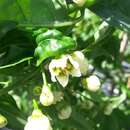en
names in breadcrumbs


Capsicum flexuosum ist eine Art aus der Gattung Paprika (Capsicum) in der Familie der Nachtschattengewächse (Solanaceae).
Capsicum flexuosum ist ein 0,5 bis zwei Meter hoher Strauch.[1] Die Laubblätter sind elliptisch bis eiförmig, häutig und nur wenig mit Trichomen besetzt. Die Blütenstände bestehen aus zwei oder drei (selten ein bis sechs) hängenden[2] Blüten. Am Kelch sind keine deutlich sichtbaren Anhängsel beziehungsweise Kelchzähne erkennbar. Die Krone ist weiß gefärbt und besitzt fünf gelblich-grüne Punkte an der Basis der Kronlappen und dem Inneren der Kronröhre. Die Früchte sind Beeren, die bei Reife rot gefärbt sind. Die Samen sind schwärzlich-braun.[3] Die Früchte sind zumeist scharf, es wurde jedoch einzelne Populationen beobachtet, die nicht-scharfe Früchte bilden.[2]
Die Chromosomenzahl ist 2n=24.[1]
Die Art ist im Nordosten Argentiniens, dem Süden und Südosten Brasiliens, sowie in Paraguay beheimatet.[4]
Nachdem die Art zunächst nahe den Artengruppen um Capsicum annuum und Capsicum baccaatum, oder aber als relativ einzelstehende Art angesehen wurde, konnte sie in phylogenetischen Untersuchungen in die Nähe der sogenannten bolivianischen Klade (bestehend aus Capsicum caballeroi, Capsicum minutiflorum, Capsicum ceratocalyx und Capsicum coccineum) gestellt werden. Diese Beziehung ist durch die Untersuchung nicht stark gesichert, zudem können keine relevanten morphologischen Gemeinsamkeiten zu diesen Arten festgestellt werden. Die Art wird daher in einer monotypischen Flexuosum-Klade geführt.[2]
Capsicum flexuosum wurde 1846 von Otto Sendtner im 10. Band der Flora Brasiliensis erstbeschrieben.[5]
Capsicum flexuosum ist eine Art aus der Gattung Paprika (Capsicum) in der Familie der Nachtschattengewächse (Solanaceae).
Capsicum flexuosum is a member of the genus Capsicum, and is native to the New World, specifically the southern regions of Brazil. Unlike most other chili peppers, it is only mildly pungent and has issues with self-compatibility.[1][2]
Capsicum flexuosum is identified by its distinctive white, green, and sometimes purple flowers. The flowers have an entire calyx and campanulate corolla that come in various color varieties, but are generally green toward the center changing to white at the petal edges . Mature fruit of C. flexuosum are tiny berries with a bullet shape about 7 mm long that ripen to red. It is propagated by seed.[3] It has a somatic chromosome number of 2n=2x=24.[1]
In Brazil, where the plants occur naturally, C. flexusoum is sometimes used as a spice.[1] Also, since it is a wild pepper species, it has been used extensively in phylogenetic studies to better understand the relationships of peppers and different gene models. This species has also been used as a "bridge species" to cross more distantly related Capsicum species to those more related to domesticated cultivars.
Capsicum flexuosum is a member of the genus Capsicum, and is native to the New World, specifically the southern regions of Brazil. Unlike most other chili peppers, it is only mildly pungent and has issues with self-compatibility.
Il Capsicum flexuosum è una specie selvatica di piante del genere Capsicum, nativa del Sud America. Essa è una specie a 24 cromosomi, facente parte del Flexuosum clade[1] ed è diffusa spontaneamente in Brasile.
Il Capsicum flexuosum è una specie selvatica di piante del genere Capsicum, nativa del Sud America. Essa è una specie a 24 cromosomi, facente parte del Flexuosum clade ed è diffusa spontaneamente in Brasile.
Capsicum flexuosum là loài thực vật có hoa trong họ Cà. Loài này được Sendtn. mô tả khoa học đầu tiên năm 1846.[1]
Capsicum flexuosum là loài thực vật có hoa trong họ Cà. Loài này được Sendtn. mô tả khoa học đầu tiên năm 1846.